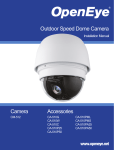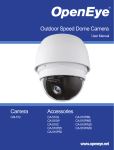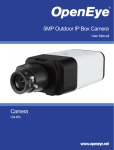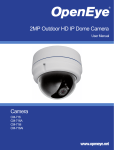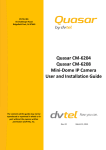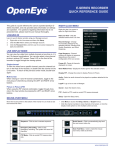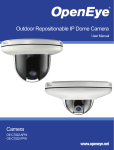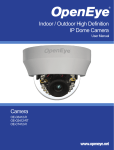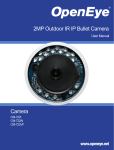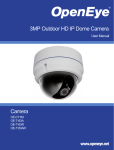Download Accessories Camera Outdoor PTZ IP Camera
Transcript
Outdoor PTZ IP Camera User Manual Camera Accessories CM-816 CA-510G CA-510W CA-510C CA-510P25 CA-510P50 CA-510PML CA-510PMS CA-510PA25 CA-510PA50 www.openeye.net 18x 2MP Outdoor IP PTZ Camera (CM-816 Rev C) User Manual Manual Edition 30875AE – DECEMBER 2014 ©2014, OPENEYE All Rights Reserved. No part of this documentation may be reproduced in any means, electronic or mechanical, for any purpose, except as expressed in the Software License Agreement. OpenEye shall not be liable for technical or editorial errors or omissions contained herein. The information in this document is subject to change without notice. The information in this publication is provided “as is” without warranty of any kind. The entire risk arising out of the use of this information remains with recipient. In no event shall OPENEYE be liable for any direct, consequential, incidental, special, punitive, or other damages whatsoever (including without limitation, damages for loss of business profits, business interruption or loss of business information), even if OPENEYE has been advised of the possibility of such damages and whether in an action or contract or tort, including negligence. This documentation is copyrighted. All other rights are reserved to OPENEYE. OPENEYE, and OpenEye, are registered trademarks of OPENEYE in the United States and elsewhere; Windows, and Windows XP Embedded are registered trademarks of Microsoft Corporation. All other brand and product names are trademarks or registered trademarks of the respective owners. OPENEYE Liberty Lake, WA ● U.S.A. 30875AE 3 Important Safeguards 1. Read Instructions Read all of the safety and operating instructions before using the product. 2. Retain Instructions Save these instructions for future reference. 3. Attachments / Accessories Do not use attachments or accessories unless recommended by the appliance manufacturer as they may cause hazards, damage product and void warranty. 4. Installation Do not place or mount this product in or on an unstable or improperly supported location. Improperly installed product may fall, causing serious injury to a child or adult, and damage to the product. Use only with a mounting device recommended by the manufacturer, or sold with the product. To insure proper mounting, follow the manufacturer's instructions and use only mounting accessories recommended by manufacturer. 5. Power source This product should be operated only from the type of power source indicated on the marking label. Precautions Operating Before using, make sure power supply and other cables are properly connected. While operating, if any abnormal condition or malfunction is observed, stop using the camera immediately and then contact your local dealer. Handling 4 Do not disassemble or tamper with parts inside the camera. Do not drop or subject the camera to shock and vibration as this can damage camera. Do not block the cooling holes on the bracket. This camera has a cooling fan inside the housing. Blocking the cooling holes will cause heat to build up and cause malfunction. Care must be taken when you clean the clear dome cover. Scratches and dust will ruin the image quality of your camera. Do not use strong or abrasive detergents when cleaning the camera body. Use a dry cloth to clean the camera when it is dirty. In case the dirt is hard to remove, use a mild detergent and wipe the camera gently. Installation and Storage Install electricity wiring carefully. Please note that input electricity to the unit is at tolerance of DC 12V/AC 24V ± 10%. The camera is capable of surge protection; ensure AC power model unit is grounded appropriately against damage by heavy current or electric shock. Do not install the camera in areas of extreme temperatures in excess of the allowable range. (-50°C ~50°C / -58°F ~ 122°F) Avoid installing in humid or dusty places. The relative humidity must be below 90%. Avoid installing in places where radiation is present. Avoid installing in places where there are strong magnetic fields and electric signals. Avoid installing in places where the camera would be subject to strong vibrations. Whether the camera is in use or not, never aim it at the sun or other extremely bright objects. Otherwise the camera may be smeared and damaged. Regulation This device complies with Part 15 of the FCC Rules. Operation is subject to the following two conditions: (1) this device may not cause harmful interference, and (2) this device must accept any interference received, including interference that may cause undesired operation. This symbol on the product or on its packaging indicates that this product shall not be treated as household waste in accordance with Directive 2002/96/EC. Instead it shall be handed over to the applicable collection point for the recycling of electrical and electronic equipment. By proper waste handling of this product you ensure that it has no negative consequences for the environment and human health, which could otherwise be caused if this product is thrown into the garbage bin. The recycling of materials will help to conserve natural resources. For more details information about recycling of this product, please contact your local city office, your household waste disposal service or the shop where you purchased the product. Compliance is evidenced by written declaration from our suppliers, assuring that any potential trace contamination levels of restricted substances are below the maximum level set by EU Directive 2002/95/EC, or are exempted due to their application Warning DANGEROUS HIGH VOLTAGES ARE PRESENT INSIDE THE ENCLOSURE. DO NOT OPEN THE CABINET. REFER SERVICING TO QUALIFIED PERSONNEL ONLY. 30875AE 5 Caution CAUTION RISK OF ELECTRIC SHOCK DO NOT OPEN CAUTION: TO REDUCE THE RISK OF ELECTRIC SHOCK, DO NOT REMOVE COVER (OR BACK). NO USER-SERVICEABLE PARTS INSIDE. REFER SERVICING TO QUALIFIED SERVICE PERSONNEL. . 6 Introduction.............................................................................................................. 11 Overview ............................................................................................................... 11 Product Features .............................................................................................. 11 Getting Started ........................................................................................................ 12 Camera Contents .................................................................................................. 12 Dome Setup and Cable COnnection .................................................................... 13 Preparations for Dome Setup ........................................................................... 13 Dome Camera Setup ........................................................................................ 16 Switch Definition ........................................................................................... 16 Dome Cable Definition and Requirements ....................................................... 17 Cable Requirements..................................................................................... 17 Power Connection ........................................................................................ 18 Grounding Recommendation ....................................................................... 18 Ethernet Cable Connection .......................................................................... 18 12-Pin Alarm Input/Output Connection ........................................................ 19 Audio Input/Output Connection .................................................................... 19 Dome Installation .................................................................................................... 20 Overview ............................................................................................................... 20 Dome Dimensions ................................................................................................. 20 Optional Accessories ............................................................................................ 21 Dome Camera Accessories .............................................................................. 21 Mounting Accessories ....................................................................................... 21 Ceiling Mounting with Pole ............................................................................... 22 Wall Mounting with Wall Mount Bracket ........................................................... 23 Wall Mounting with Corner Mount .................................................................... 25 Pole Mounting ................................................................................................... 26 Locate Camera ......................................................................................................... 27 OpenEye Network Camera manager .................................................................... 27 Installation ......................................................................................................... 27 Starting Network Camera Manager .................................................................. 27 Device Addressing ............................................................................................ 28 Finding Network Devices.............................................................................. 28 Setup & Configuration ............................................................................................ 29 30875AE 7 Connecting to the Camera .................................................................................... 29 Administrator/User Privileges ........................................................................... 29 Connecting a Stream ........................................................................................ 30 Connecting Over the Internet ........................................................................... 31 Viewer Software .................................................................................................... 32 Viewer Tabs ...................................................................................................... 32 Home ................................................................................................................ 33 System .............................................................................................................. 35 System ......................................................................................................... 35 Security ........................................................................................................ 37 Admin Password ...................................................................................... 37 Add User .................................................................................................. 38 Delete User .............................................................................................. 38 Edit User .................................................................................................. 38 Network ........................................................................................................ 39 Get IP address automatically (DHCP) ..................................................... 39 Use Fixed IP Address .............................................................................. 39 QoS (Quality of Service) .......................................................................... 41 SNMP....................................................................................................... 41 UPnP (Universal Plug and Play) .............................................................. 42 DDNS ........................................................................................................... 43 Mail ............................................................................................................... 44 FTP............................................................................................................... 45 HTTP ............................................................................................................ 46 Application .................................................................................................... 47 Alarm Pin Selection ...................................................................................... 48 Alarm Pin Status Settings ............................................................................ 49 Motion Detection .......................................................................................... 51 Storage Management ................................................................................... 54 Recording ..................................................................................................... 56 Activating Micro SD/SDHC Card Recording ............................................ 56 Snapshot ...................................................................................................... 57 Information ................................................................................................... 58 System Log .............................................................................................. 58 View User Information .................................................................................. 59 View User Privilege .................................................................................. 59 Parameter List .............................................................................................. 60 Software Upgrade ........................................................................................ 61 Upgrading the Camera Viewer Software ................................................. 61 8 Maintenance ................................................................................................. 62 Video and Audio Streaming Settings ................................................................ 63 Video Format ................................................................................................ 63 Video Resolution ...................................................................................... 64 Text Overlay Settings............................................................................... 64 Video Rotate Type ................................................................................... 65 GOP Settings ........................................................................................... 65 H.264 Profile ............................................................................................ 65 Video Compression ...................................................................................... 66 Video OCX Protocol .......................................................................................... 67 Multicast Mode ......................................................................................... 67 Frame Rate Control ...................................................................................... 68 Audio ............................................................................................................ 69 Transmission Mode.................................................................................. 69 Server Gain Settings ................................................................................ 69 Bit Rate .................................................................................................... 70 PTZ Settings ......................................................................................................... 71 Preset................................................................................................................ 71 Preset Setting ............................................................................................... 71 Preset Go ..................................................................................................... 72 Pattern .............................................................................................................. 72 Pattern Setting .............................................................................................. 72 Pattern Run .................................................................................................. 73 Auto Scan ......................................................................................................... 73 Auto Scan Setting ......................................................................................... 74 Auto Scan Run ............................................................................................. 74 Tour................................................................................................................... 75 Tour Set ........................................................................................................ 76 Tour Run....................................................................................................... 76 Home ................................................................................................................ 77 Home Settings .............................................................................................. 77 Tilt Range.......................................................................................................... 77 Privacy Mask Settings ...................................................................................... 79 Mask Setting ................................................................................................. 80 Mask Clearing .............................................................................................. 80 Camera — Exposure ........................................................................................ 81 Camera — White Balance ................................................................................ 82 30875AE 9 Camera — Misc1 .............................................................................................. 84 Camera — Misc2 .............................................................................................. 86 Camera — Default ............................................................................................ 87 Logout ................................................................................................................... 87 Specifications .......................................................................................................... 88 Camera Specifications .......................................................................................... 88 PTZ Specifications ................................................................................................ 90 IP Specifications ..................................................... Error! Bookmark not defined. 10 The CM-816 IP camera can transmit video in H.264 and MJPEG, up to 2MP (1080p) high definition video. The 816 is capable of quad and dual streaming both codecs at various resolutions. The camera’s IR cut filter and wide dynamic rage imaging make it perfect for installations with difficult lighting conditions. The CM-816 has an IP66 outdoor rating and integrated heater making the 816 ideal for rugged outdoor installations with temperature as low as -49°F (-45°C) Product Features 30875AE 18x optical zoom 2 megapixel resolution Simultaneous dual streams: H.264 and MJPEG Full HD real-time resolution Two-way audio support Removable IR cut filter Motion detection Wide Dynamic Range (WDR) Digital noise reduction 11 Before proceeding, please check that the box contains the items listed here. If any item is missing or has defects, do not install or operate the product and contact your dealer for assistance. 1 M3 Standard Screw 1 M3 Security Screw 1 M5 Standard Screw Dome Body 12 1 M5 Security Screw Optical Cover Security Torx Tool Waterproof Gasket Lubricant Quick Start Guide CD Before installing or connecting the dome camera, please refer to this section and complete preparations for dome setup and all switch settings. Preparations for Dome Setup The following installation procedure is for the outdoor dome equipped with the sunshield housing. Please follow the steps below to complete dome housing installation. 1. Unpack the dome package and take out the dome body. 2. 30875AE Rotate the top holder and take it off from the dome body. 13 14 3. Remove the protective cover and PE sheet. 4. Apply some lubricant on the cover’s waterproof gasket. This helps make the installation process smoother. 5. Attach the dome cover to the camera body. 6. Note that the tiny protrusion on the cover must align with one of the four holes on the camera body. 7. Using both hands, gently press the dome cover. DO NOT press the dome itself as this may cause damage to the dome or camera. 8. 30875AE Screw the dome cover and body together. 15 Dome Camera Setup Please refer to the following figure for connection and switch locations and definitions. Alarm input/output connections Reboot Power connection Audio connection RJ-45 connector SD card Do not change the settings on the camera’s settings switches. Leave the switches at the factory default settings. 16 Dome Cable Definition and Requirements For operation, the IP dome camera requires a network cable to carry the video signals to the remote viewing site and a power cable to power the dome. For operation, the CM-816 IP camera requires 24V AC power to the dome. Power Wire Length Specifications Wire Gauge Maximum Distance Wire Gauge Maximum Distance 22 27 feet 14 175 feet 20 44 feet 12 279 feet 18 69 feet 10 444 feet 16 110 feet Ensure that the power supply corresponds with the dome’s power requirement or the camera may be damaged. Contact a qualified maintenance engineer with any problems. Network Cable Length Specifications Cable Type Maximum Distance Wire Gauge Maximum Distance CAT5 300 feet CAT6 300 feet CAT5e 300 feet CAT6a 300 feet An Ethernet crossover cable can be used to connect the camera directly to a PC during configuration. 30875AE 17 1. Connect POSITIVE 24 volt AC power to pin 1. 2. Connect ground wire to pin 2. 3. Connect NEGATIVE 24 volt AC power to pin 3. The ‘notches’ on the left side of the graphic above correspond to notches in the green plastic of the power connector. Be careful not to pull the cables improperly during installation. OpenEye suggests that you fasten the cables after installation is complete. The GND (ground) wire must be directly connected to the middle pin of the AC24V power connector. Failure to connect the ground can cause damage and failure of the camera and may void the warranty. Connect one end of the CAT 5 Ethernet cable to the RJ-45 connector of the camera and the other end of the cable to the network switch or recorder. In some cases, you may need to use an Ethernet crossover cable when connecting the camera directly to the recorder. Check the status of the link indicator and activity indicator LEDs. If the LEDs are unlit, check the LAN connection. The Green link light indicates a good network connection. AUTO IRIS The Orange activity light flashes to indicate network activity. DC12V RESET NETWORK LINE OUT VIDEO DC 1 2 3 4 LINE IN MIC IN I/O 18 Using the 12-pin connector, installers can connect 4 digital alarm inputs and 2 digital alarm outputs. The alarm pins are serviceable for connecting alarm input and output devices such as sensors, sirens, or flashing lights to the surveillance system. For the definition of each pin, refer to the list below. 30875AE Pin Definition 1 Alarm OUT NO 1 2 Alarm OUT NC 1 3 Alarm OUT COM 1 4 GROUND 5 Alarm OUT NO 2 6 Alarm OUT NC 2 7 Alarm OUT COM 2 8 GROUND 9 Alarm IN 4 10 Alarm IN 3 11 Alarm IN 2 12 Alarm IN 1 1. Line OUT 2. GROUND 3. Line IN 19 Depending on your installation environment, the dome can be installed on the ceiling, on a wall, or a pole. The following section illustrates installation methods and procedures for installing the dome and mounting accessories. The dome dimensions are Ø172 x 228.71mm (6.77 x 9.0 inches) and Ø191.97 x 282.11mm (7.5 x 11.1 inches) with the sunshield. 20 Dome Camera Accessories Transparent/Smoke Cover Part Number: CA-510-DT Mounting Accessories Wall Mount Bracket (w/ Anti Drop) Part Number: CA-510W Long Wall Mount Bracket (w/ Anti Drop) Part Number: CA-510WL 50 cm Pole Part Number: CA-510P50 25 cm Pole Part Number: CA-510P25 Corner Mounting Plate Part Number: CA-510C Small Pole Mount Part Number: CA-510PMS Large Pole Mount Part Number: CA-510PML 1 ¼” Threaded Adapter Part Number: CA-510PA25 1 ½” Threaded Adapter Part Number: CA-510PA50 30875AE 21 Ceiling Mounting with Pole The pole is available in two lengths: 25 cm and 30 cm. Items Needed: Tools Needed: Dome Camera Drill Ceiling Pole Accessory Screwdriver Waterproof Gasket (supplied) Screws and Anchors appropriate for the mounting surface (not supplied) Installation Steps: Ensure that the ceiling can support the weight of the dome camera and the ceiling pole. 1. Cut a cable access hole in the ceiling. 2. Attach the ceiling pole to the ceiling with the appropriate screws and screw anchors (not provided). 3. Attach the waterproof gasket to the Ceiling Pole. 4. Thread the cables through the ceiling pole and the top holder After threading the cables through the tube, block the cable entry hole with the supplied sponges to prevent insects from entering the tube. 22 5. Attach the top holder to the ceiling pole with the supplied screws and washers and adjust the gasket to the junction of the ceiling pole and the top holder. 6. Connect the cables to the dome camera. 7. Attach the dome to the top holder and secure them with the supplied screw. Wall Mounting with Wall Mount Bracket Items Needed: Tools Needed: Dome Camera Drill Wall Mount Bracket or Long Wall Mount Bracket Screwdriver Waterproof Gasket (supplied) Screws and Anchors appropriate for the mounting surface (not supplied) Installation: 30875AE 1. Cut a cable access hole on the wall. Cables can also be threaded through the cable entry knockout on the tube if desired. 2. Thread the cables through the wall mount bracket. 3. Block the cable entry hole with the supplied sponge. 23 24 4. Attach the wall mount bracket to the wall with the appropriate screws and screw anchors (not provided). 5. Attach the waterproof gasket to the wall mount bracket. 6. Thread the cables through the top holder and attach the dome to the wall mount bracket with the supplied screws and washers. 7. Connect the cables to the dome camera. 8. Attach the dome to the top holder and secure them with the supplied screw. Wall Mounting with Corner Mount The corner mount must be used in conjunction with the wall mount bracket. Items Needed: Tools Needed: Dome Camera Drill Wall Mount Bracket Accessory Screwdriver Corner Mounting Plate Waterproof Gasket (supplied) Screws and Anchors appropriate for the mounting surface (not supplied) Installation: 30875AE 1. Cut a cable access hole on the wall. Cables can also be threaded through the cable entry knockout on the bracket if desired. 2. Secure the corner mount plate on the corner wall with the appropriate screws and screw anchors. 3. Attach the wall mount bracket to the corner mount plate with the supplied screws and washers. 4. Thread the cables through wall mount bracket and the top holder. 5. Block the cable entry hole with the supplied sponge. 6. Attach the waterproof gasket to the wall mount bracket. 7. Attach the top holder to the wall mount bracket with the supplied screws and washers and adjust the gasket to the junction of the wall mount bracket and the top holder. 8. Connect the cables to the dome camera. 9. Attach the dome to the top holder and secure them with the supplied screw. 25 Pole Mounting The dome can be mounted on a pole with the small or large direct mounting accessory and a wall mount bracket. Items Needed: Tools Needed: Dome Camera Stainless Steel Strap Cutter Wall Mount Bracket Accessory Screwdriver Small/Large Pole Mount Accessory Stainless Steel Straps Waterproof Gasket (supplied) Installation Steps: 26 1. Fasten the small/large pole mount to the pole with stainless steel straps. 2. Attach the wall mount bracket to the pole mount with the supplied screws and washers. 3. Attach the waterproof gasket to the wall mount bracket. 4. Thread the cables through the wall mount and the top holder. 5. Block the cable entry hole with the supplied sponge. 6. Attach the top holder to the wall mount with the supplied screws and washers and adjust the gasket to the junction of the wall mount and the top holder. 7. Connect the cables to the dome camera. 8. Attach the dome to the top holder and secure them with the supplied screw. Use the included Network Camera Manager software to easily find your network cameras for initial setup. The OpenEye IP Finder software is included on the CD with all OpenEye IP devices. Installation You can install Network Camera Manager on any personal computer (PC) or laptop using the software CD included with your OpenEye IP camera or by downloading the program from openeye.net. Network Camera Manager will only work on PCs or laptops that use a Windows operating system. It is compatible with Windows XP, Vista, 7, and 8. Starting Network Camera Manager After installing the program on your PC or laptop, open the program to begin configuring your cameras. To access Network Camera Manager on an OpenEye recorder, you must operate the recorder in Windows Mode. 30875AE 1. In the Live Screen, click Exit. 2. Click Restart in Windows Mode. 3. Click OK. 4. Double-click Network Camera Manager. 27 Device Addressing The functions on the Device Addressing tab allow you to find, configure, and view network cameras. 28 1. Click Find Devices on the Device Addressing tab. 2. To narrow your search by Camera Model, Project, or Camera Name, select your desired criteria from the appropriate lists. 1. Locate the camera on the Network Camera Manager list. 2. Double-click the camera to open the Viewer software in your web browser. 3. Log in to the camera with the appropriate User Name and Password. The default User name is Admin and the default Password is 1234. The username and password are case sensitive. OpenEye recommends you change the Admin password for security reasons. Administrator/User Privileges The Administrator account has the authority to configure the IP camera and authorize users’ access to the camera. The User accounts have access to the camera with limited authority. 30875AE 29 Connecting a Stream OpenEye IP cameras are optimized for use with OpenEye recorders, but you can also connect to your OpenEye IP cameras using third party software like VLC media player (http://www.videolan.org). To connect the camera you may need to provide the stream URL. All OpenEye IP cameras are capable of delivering two RTSP streams, as well as streaming MJPEG over HTTP. The stream URLs are listed below. rtsp://<ip address>/mjpeg rtsp://<ip address>/mpeg4 rtsp://<ipaddress>/h264 http://<ipaddress>:8008 The MJPEG over HTTP stream is identified by a port number. The default port is 8008; this port can be configured in the cameras Network page: 30 Connecting Over the Internet There are some challenges with connecting to OpenEye IP cameras over WAN (internet) connections because the camera streams video over RTSP. RTSP is an excellent protocol for media and is now used on many IP cameras (including OpenEye) as the default streaming option. However, RTSP is not suitable for transmission between two locations that are behind different routers. In this case, the client (for example, the OpenEye HVR or NVR server software) connects to the camera, then requests a stream. The camera uses that connection to return a stream, but since the connection originated on the client side and has now switched to the camera (remote) side, the router does not have any way to determine where the traffic should be routed, so no video appears at the recorder. There are three solutions to this: 1. Connect modems on both sides directly to the recorder and camera. If there is no router, no network address translation is needed. 2. Use routers with VPN support and set up a small VPN. Once this is done, the traffic will be treated as though it were all on the local network. 3. (Best solution) – Use routers with connection tracking. This is quite easy; VOIP also uses RTSP and faces the same challenges. If a router is marketed as having “VOIP Support”, it will have the necessary connection tracking capability to allow any type of RTSP communication (not just VOIP). With proper planning and the correct equipment, RTSP cameras CAN stream over the WAN to a recording device for minimal additional cost and labor. Please contact OpenEye support if you require any additional information on these topics. 30875AE 31 To access the setup menu, you need to install the viewer software on your PC or DVR. The viewer software will install automatically the first time you connect to the camera. If your internet browser doesn’t install the viewer software, check the security settings or ActiveX controls and plug-in settings. If your internet browser asks for permission to install the ActiveX control, you must allow the ActiveX control to continue the installation. Viewer Tabs Home – Monitor live video. System – Set the host name, system time, root password, and network related settings. (Admin access only) Streaming – Modify the video resolution and select the audio compression type. PTZ – Adjust the camera parameters including Exposure, White Balance, Backlight Compensation and program functions including Presets, Pattern, Auto Scan, and Tour. Logout – Change user. 32 Home Screen Size Adjustment Image display size can be adjusted to x1/2 and full screen via the related buttons. To switch between the normal view mode and full screen view mode, users can also move the cursor to the live video pane and right-clink to display the screen options. Click Normal View or Fullscreen to set the image display mode. Talk The Talk function allows the local site to talk to the remote site (camera location). This function is only available if the local site has a connected microphone, the remote site has connected speakers, and the local user has been granted access. Please refer to the Security: Add user > Talk/Listen section for further details. This function is only available to users who have been granted this privilege by the Administrator. Listen The Speaker function allows the local site to listen to audio from the remote site (camera location). This function is only available if the local site has connected speakers, the remote site has a connected microphone, and the local user has been granted access. Please refer to the Security: Add user > Talk/Listen section for further details. This 30875AE 33 function is only available to users who have been granted this privilege by the Administrator. Snapshot Click the Snapshot button, and a JPEG snapshots will automatically be saved in the designated location on the local workstation. The default place of saving snapshots is: C:\. This location can be changed in File Location under the System menu. If you are using Windows Vista or 7, you will need to change the snapshot location. Windows UAC does not allow internet programs to write directly to C:\ for security reasons. Record Click the Record button to start recording live video; press the record button again to stop recording live video, automatically saving an AVI video clip to the designated location on the local workstation. The default place of saving video clips is: C:\. This location can be changed in File Location under the System menu. If you are using Windows Vista or 7, you will need to change the video clip location. Windows UAC does not allow internet programs to write directly to C:\ for security reasons. Pan/Tilt Control To implement pan/tilt control, move the cursor to the live video pane and drag the pointer in the desired direction. Zoom Adjustment Click on the wide/tele buttons to control zoom in/out. Or move the cursor to the zoom adjustment bar and click the desired position to change the room ratio. Or you can zoom in/out by first moving the cursor to the live video pane and rotating the mouse wheel. Focus Adjustment Auto Focus (Continuous AF): Click Auto to enable auto focus mode. In this mode, the camera will automatically and continuously adjust focus regardless of zoom changes or any view changes. The Focus status will also be displayed above the live video pane. Manual Focus: Click on Manual to adjust focus manually via the Near and Far buttons. The status will also be displayed above the live video pane. 34 System The System tab is only accessible by the Administrator. Host Name The Host Name is used to identify the camera on your system. If camera based Motion Detection is enabled and is set to send alarm message by Mail/FTP, the host name entered here will display in the alarm message. Time Zone Select the appropriate time zone from the dropdown. 30875AE 35 Enable Daylight Savings Time Select to enable daylight savings time, then select the offset, start date and end date. In North America the typical offset is one hour (01:00:00); the start is the second Sunday in March at 2AM (02:00:00), and the end is the first Sunday in November at 2AM (02:00:00). Sync with Computer Time Select to synchronize the camera date and time with the connected PC or DVR. Manual Set video date and time manually. Sync with NTP Server Network Time Protocol (NTP) is an alternate way to set your camera’s clock by synchronizing with a NTP server. Specify the server you wish to synchronize in the NTP Server box. Then select an Update Interval. For more information about NTP, visit www.ntp.org. 36 Admin Password To change the administrator password, type a new password in the Admin Password box and confirm below. The maximum length of the password is 14 characters. The following characters are valid: A-Z, a-z, 0-9, !#$%&’-.@^_~. 30875AE 37 Add User The user name and passwords are limited to 16 characters. There is a maximum of twenty user accounts 1. Type the new User name and Password 2. Select the appropriate check boxes to give the user Camera Control, Talk and Listen permissions. I/O Access – Basic functions that enable users to view video when accessing to the camera. Camera Control – Allows the User to change camera parameters on the Camera tab. Talk/Listen – Talk and Listen functions allow the user at the local site (DVR) to communicate with, the administrator at the remote site. 3. Click Add. Delete User 1. Select the user name on the User Name list under Manage User. 2. Click Delete to remove the user. 1. Select the user name on the User Name list under Manage User. 2. Click Edit to edit the user password and permissions. 3. Type a new password or the existing password in the User password box Edit User You must type a password in the User password box to make any changes to an account. For security reasons, every time the user properties are opened the access check boxes are automatically cleared. Make sure you select any user access options each time you edit the user properties. 38 You can choose to use a fixed IP address or dynamic (DHCP) IP address for the camera. Get IP address automatically (DHCP) The camera comes preconfigured with a fixed IP address. Each camera has a unique Media Access Control (MAC) address, which can be used to identify the camera on the network. Record the IP Camera’s MAC address, which can be found using the OpenEye IP Finder application and on the label of the camera, for identification in the future. Use Fixed IP Address To set up a new static IP address: 30875AE 1. Select the Use fixed IP address option. 2. Type a new IP address in the IP address box. 3. Type a new address in the Default Gateway box. 4. Click Save to confirm the new setting. 39 When using static IP address to log in to the IP Camera, you can access it either through OpenEye IP Finder software or type the IP address directly in the address bar of your Internet Explorer. General IP address – The IP Address is necessary for network identification. Subnet mask – Used to determine if the destination is in the same subnet. The default value is 255.255.255.0. Default gateway – Used to forward frames to destinations on different subnets or for internet access. Primary DNS – The primary domain name server that translates hostnames into IP addresses. Secondary DNS – A secondary domain name server that backups the primary DNS. Advanced Web Server port – Defines the port that Internet Explorer uses to connect over the web and view video. If this port is changed then the new port must be defined when attempting to web connect (ex: if your camera’s IP address is 192.168.0.100 and you change the web port to 8001, then you must type http://192.168.0.100:8001 in your browser). This is also the port used in OpenEye Server Software. RTSP port – The default RTSP port is 554; setting range: 1024 ~65535. MJPEG over HTTP port – The default HTTP Port is 8008; setting range: 1024 ~65535. HTTPS port – The default HTTPS Port is 443; setting range: 1024 ~65535. No port number can be used in duplication on more than one item. IPv6 Address Configuration To enable IPv6 select Enable IPv6 and click Save. See your network administrator if you are unsure of your network configuration. 40 QoS (Quality of Service) Quality of Service allows you to prioritize network traffic services of the camera’s functions. The QoS function utilizes the Differentiated Services prioritized using Codepoint values (DSCP). Routers and switches on the network must be QoS or DSCP capable, and have these settings enabled for this function to operate on your network. DSCP Settings The DSCP value range is 0 to 63. The default value is 0, which indicates the function is disabled; and rates 1 as the highest priority, and 63 as the lowest priority. Video DSCP: prioritize video streaming over HTTP or RTSP Audio DSCP: prioritize audio streaming Management DSCP: prioritize web interface traffic over HTTP SNMP With Simple Network Management Protocol (SNMP) enabled, the camera can be monitored and managed remotely with a network management system. Contact your network administrator if you are not familiar with SNMP setup. SNMP v1/v2 Enable SNMP v1 Enable SNMP v2 Read Community: Specify the community name that has read-only access. Write Community: Specify the community name that has read/write access. Traps for SNMP v1/v2 Traps are used to send a message to the network management system for important events or status changes. 30875AE Enable Traps: enables trap reporting Trap Address: enter the IP address of the network management system Trap Community: enter the community to use when sending trap messages 41 UPnP (Universal Plug and Play) 42 Enable UPnP: When enabled the camera will appear in My Network Places on Windows computers running UPnP on the same network. Enable UPnP Port Forwarding: When enabled the camera will attempt to open the web server port on the router automatically. Friendly Name: Set a name to easily identify the camera. DDNS (Dynamic Domain Name Service) is a service that allows a connection to an IP address using a hostname (URL) address instead of a numeric IP address. Most Internet Service Providers use Dynamic IP Addressing that frequently changes the public IP address of your internet connection; this means when connecting to the camera over the internet you need to know if your IP address has changed. DDNS automatically redirects traffic to your current IP address when using the hostname address. 30875AE Enable DDNS – Select the check box to enable DDNS. Provider – Select a DDNS host from the Provider list. Host name – Type the registered domain name in the field. Username/E-mail – Type the username or e-mail required by the DDNS provider for authentication. Password/Key – Type the password or key required by the DDNS provider for authentication. 43 The camera can send an e-mail via Simple Mail Transfer Protocol (SMTP) when motion is detected or when the sensor input is activated. SMTP is a protocol for sending e-mail messages between servers. SMTP is a relatively simple, text-based protocol, where one or more recipients of a message are specified and the message text is transferred. Two sets of SMTP accounts can be configured. Each set includes SMTP Server, Account Name, Password and E-mail Address settings. For specific SMTP server information, contact your network service provider. 44 The camera can send alarm messages to a specific File Transfer Protocol (FTP) site when motion is detected or when the sensor input is activated. You can assign alarm messages to up to two FTP sites. 30875AE Enter the FTP details, which include server, server port, user name, password and remote folder, in the appropriate boxes and click Save when finished. 45 The camera can send alarm messages to a specific Hypertext Transfer Protocol (HTTP) site when motion is detected or when the sensor input is activated. You can assign alarm messages to up to two HTTP sites. 46 Enter the HTTP details, which include server, user name and password, in the appropriate boxes and click Save when finished. The CM-816 supports 4 digital alarm inputs and 2 digital alarm outputs. Make sure the alarm connections are properly wired before starting to configure alarm related settings on the Application screen. Refer to the pin definition table below for alarm system wiring. 30875AE Pin Definition 1 Alarm OUT NO 1 2 Alarm OUT NC 1 3 Alarm OUT COM 1 4 GROUND 5 Alarm OUT NO 2 6 Alarm OUT NC 2 7 Alarm OUT COM 1 8 GROUND 9 Alarm IN 4 10 Alarm IN 3 11 Alarm IN 2 12 Alarm IN 1 47 Select an alarm pin from the Alarm Pin Selection box and click Edit to start alarm programming. 48 Alarm Setting Alarm Switch – Enable or disable the alarm function. Alarm Type – Select an alarm type (Normal Close or Normal Open) that corresponds with the alarm application. Trigger Action (Multi-Option) Specify alarm actions that will take place when the alarm is triggered. 30875AE Enable Alarm Output – Select this option to activate the alarm output. Record Stream to SD Card – Select this option to record to an internally installed SD card when this alarm is activated. 49 PTZ Function – Assign a PTZ function (Preset, Tour, Auto Scan or Pattern) for the camera to perform when this alarm is activated. If Preset is selected, you will be prompted to enter a Dwell Time (1~256). This is the time in seconds that the camera will remain at that Preset location, and then it will return to the location that it was pointing at the time the alarm occurred. Refer to the sections on Presets, Tours, Auto Scans, or Patterns later in this manual for more details. Send Message by FTP/E-Mail – Select to send an alarm message by FTP and/or E-Mail when this alarm is activated. Upload Image by FTP/E-Mail – Select to send an image by FTP and/or E-Mail when this alarm is activated. Send HTTP Notification – Select to send a notification to a HTTP server. E-Mail, FTP, and HTTP options will also need to be configured within their corresponding menus. See the Mail, FTP or HTTP sections previously in this manual for more details. File Name Enter a file name in the box (the examples below used “image.jpg” for the file name). The uploaded image’s file name format can be set in this section. Please select the one that meets your requirements. 50 Add date/time suffix File name: imageYYMMDD_HHNNSS_XX.jpg Y: Year, M: Month, D: Day H: Hour, N: Minute, S: Second X: Sequence Number Add sequence number suffix (no maximum value) File name: imageXXXXXXX.jpg X: Sequence Number Add sequence number suffix (limited value) File Name: imageXX.jpg X: Sequence Number The file name suffix will end at the number being set. For example, if the setting is up to “10”, the file name will start from 00 and end at 10, and then start all over again. Overwrite – The original image on the FTP site will be overwritten by the new uploaded file with a static filename. Motion Detection allows the camera to detect motion and trigger alarms when motion in the detected area exceeds the determined sensitivity threshold value. On the Motion Detection page, there is a motion detection window (red box) displayed on the Live View Pane. The Motion Detection window defines the motion detection area. To change the size of the Motion Detection window, drag the edge of the frame to resize. You can add up to 10 motion detection windows. 30875AE Click Add under the Live View Pane to add a Motion Detection window. To delete a Motion Detection window, use the mouse to select the frame and click delete. 51 When motion detection is activated, the Motion pop-up window will open. When motion is detected, the signals will be displayed on the Motion window as shown below Motion Detection Turn motion detection on or off. The default setting is Off. Motion Detection Setting In the Motion window the red line provides a motion detection threshold indication; and the blue line provides a representation of motion being detected. For the camera to register a motion event, the blue line must move above the red line. After changing any of these four settings you must click Save to apply the change. 52 Sampling pixel interval [1-10] – Default value is 10, which means system will take one sampling pixel for every 10 pixels. Detection level [1-100] – Default detection level is 10. This item sets the detection level for each sampling pixel; the smaller the value, the more sensitive it is. Sensitivity level [1-100] – The default sensitivity level is 80, which means if 20% or more sampling pixels are detected as changed, the system will detect motion. The bigger the value, the more sensitive it is. As the sensitivity value is increased, the red horizontal line in the motion indication window will be lowered accordingly. Time interval (sec) [0-7200] – The default interval is 10. The value is the interval between each detected motion event. Triggered Action Once motion detection has been fine tuned, the Triggered Action can be configured if you want the camera to take one of these actions upon sensing motion. Enable Alarm Output – Select to trigger the alarm output on the camera on motion detection. Record Stream to SD Card – Select this option to record to an internally installed SD card when this alarm is activated. Send Alarm Message by FTP/E-Mail – Select to send an alarm message by FTP and/or E-Mail when this alarm is activated. Upload Image by FTP/E-Mail – Select to send an image by FTP and/or E-Mail when this alarm is activated. Send HTTP Notification – Select to send a notification to a HTTP server. E-Mail, FTP, and HTTP options will also need to be configured within their corresponding menus. See the Mail, FTP or HTTP sections previously in this manual for more details. File Name – Enter a file name in the box (the examples below used “image.jpg” for the file name). The uploaded image’s file name format can be set in this section. Please select the one that meets your requirements. 30875AE Add date/time suffix File name: imageYYMMDD_HHNNSS_XX.jpg Y: Year, M: Month, D: Day H: Hour, N: Minute, S: Second X: Sequence Number Add sequence number suffix (no maximum value) File name: imageXXXXXXX.jpg X: Sequence Number Add sequence number suffix (limited value) File Name: imageXX.jpg X: Sequence Number The file name suffix will end at the number being set. For example, if the setting is up to “10”, the file name will start from 00 and end at 10, and then start all over again. Overwrite – The original image on the FTP site will be overwritten by the new uploaded file with a static filename. 53 Storage Management allows you to view information about an inserted Micro SD/SDHC card (up to 32GB), format the SD card, adjust cleanup settings, and download or delete files stored on the SD card. Device Information – When a compatible Micro SD/SDHC card is inserted into the camera, information about the card will be displayed in this section. Device Setting – The Micro SD/SDHC card can be formatted using the Format button. A newly inserted card should always be formatted upon insertion before recording to it is configured. Disk Cleanup Setting – An automatic cleanup can be configured so that once the available storage on the Micro SD/SDHC card reaches a percentage of use, older items will be removed. To enable Disk Cleanup: 54 1. Select Enable automatic disk cleanup. 2. Enter a percentage of use threshold needed to trigger the cleanup. 3. Enter a number of days or weeks as a deletion point 4. Data older than the specified number of days or weeks will be automatically deleted when the percentage of use threshold is triggered. Recording List - Each file recorded to the Micro SD/SDHC card will be listed in the Recording List. The maximum file is 60MB per file. The letters A/M/R appear at the beginning of each file, denoting the type of recording. A for alarm; M for motion; and R for regular recording. 30875AE To remove a file, select the file from the list and click Remove. Click Sort to sort the list. To download a file, select the file from the list and click Download. 55 The recording schedule allows you to set up scheduled recording to a local Micro SD/SDHC card. Activating Micro SD/SDHC Card Recording To set up continuous micro SD/SDHC card recording: 1. Select Always to continually record until the card is full. 2. To set the camera to overwrite old data, see the instructions for Disk Cleanup Setting earlier in this section. To create a recording schedule: 1. Select Only during time frame. 2. Select the days of the week you want to record 3. Specify the Start Time and Duration of each recording. To stop recording data to the micro SD/SDHC card, select Disable. 56 The CM-816 camera supports JPEG snapshot function. You can specify a storage location for the snapshots. The default setting is: C:\. If you are using Windows Vista or 7, you will need to change the Snapshot location. Windows UAC does not allow internet programs to write directly to C:\ for security reasons. Make sure the selected file path contains valid characters such as letters and numbers. 30875AE 57 The Information page to contains the System Log, User Information, and Parameter List. System Log Click System Log to view the system log file. The content of the file provides useful information about configuration and connections. 58 The Administrator can view each user’s login information and privileges on the View User Information page All the users in the network are listed under User information. The example below shows that the Admin password is 1234. View User Privilege Select a user account from the list and click get user privacy to view the permissions for the user account. 30875AE 59 Click Parameter List to view the system parameter settings. 60 Upgrading the Camera Viewer Software Make sure the software upgrade file is available before starting the software upgrade. 1. Click Browse and find the upgrade file. Do not change the file name, or the system will fail to find the file. 30875AE 2. Select the file name from the list under Step 2. 3. Click Upgrade. The system will check to find the upgrade file, and then start to upload the upgrade file. The upgrade status bar will display on the page. When it reaches 100%, the viewer will return to Home page. 4. Close the internet browser. 5. Go to the Windows Control Panel and double-click Add or Remove Programs. Locate the Camera Viewer software on the Currently installed programs list and click Remove to uninstall the previous software version. 6. Open the internet browser again and log in to the CM-816. The system will automatically download the new version of the Camera Viewer software. 61 On the Maintenance page you can export the cameras current configuration, or import the configuration for a camera. Use the factory default page to reset the IP Camera to factory default settings if necessary. Do not import configuration files from different models of cameras. Set Default –To reset the IP camera to the factory default settings, including the default IP address, click Set Default. The system will restart after 30 seconds. If you cannot access the camera menu, you can return the camera to the factory default settings by holding down the reset button on the camera connection board for 30 seconds. See Error! Reference source not found. for the button location. Reboot – To restart the IP camera without changing the current camera settings, Click Reboot. Export – You can save the system settings by exporting the configuration file (.bin) to a specified location for future use. Click Export, then Save, and specify the desired location. Upload – To copy an existing configuration file to the IP camera, click Browse, select the desired configuration file, then click Upload. 62 Video and Audio Streaming Settings On the Streaming tab, the Administrator can configure specific video resolution, video compression mode, video protocol, audio transmission mode, etc. Select the desired video resolution for the camera on the Video Format page. The recorder will record video based on the resolution selected here. 30875AE 63 Video Resolution The camera provides four codec options under video resolution (two single streaming options and two sets of dual streaming options): MJPEG only H.264 only MJPEG + H.264 H.264 + H.264 Once a codec option is selected, multiple resolutions are available for each stream. MJPEG Resolutions* H.264 Resolutions* 1920x1080 1920x1080 1920x1080 (@ 15 FPS) 1280x1024 1280x1024 1280x720 1280x720 1024x768 1024x768 800x600 800x600 720x480 720x480 640x480 640x480 352x240 352x240 *All resolutions are at 30 Frames Per Second (FPS) unless otherwise noted. Due to resource management, some resolutions may be unavailable when selecting a dual stream option. Due to resource management, the Motion Detection, 3DNR, and Privacy Mask functions are not available when using the H.264 Only codec option and selecting the Low Latency H.264 format. Text Overlay Settings Text Overlay allows you to select text to be display over the video. Three options are available: Date, Time, and a Custom String (up to 20 alphanumeric characters). 64 Video Rotate Type You can change the orientation of the video output if necessary. Normal Video – This is the default rotation designed for a normal setup with the camera mounted with the dome facing down. Flip Video – This option will vertically flip the video image (without the intervention of another device this may cause the reversal of perceived left and right when viewing the image). Mirror Video – This option will horizontally flip the video image (without the intervention of another device this may cause the reversal of perceived left and right when viewing the image). 90 Degree Clockwise – This option will rotate the video image 90 degrees to the right. 180 Degree Rotate – This option will rotate the video image 180 degrees (this is the option most commonly needed if the image appears upside-down when the camera is first installed). 90 Degree Counterclockwise – This option will rotate the video image 90 degrees to the left. GOP Settings The Group of Pictures settings allow you to modify the frame structure of the video stream. This setting changes the frequency of the I-frames that occur within the stream of P-frames (2~64). Increasing this number increases the number of P-frames between each I-frame; decreasing the file size of the stream, but increasing the risk of video decoding errors. Decreasing this number decreases the number of P-Frames between each I-frame; increasing the file size of the stream, but decreasing the risk of video decoding errors. H.264 Profile The H.264 Profile may need to be changed if you are using a third party recorder that is not capable of decoding H.264 Main Profile video compression. Select the compatible compression type for each stream if necessary. 30875AE 65 You can select an MJPEG/H.264 compression mode on the video compression page appropriate for your application. You can also select to display compression information on the Home page. MJPEG Compression settings include: high compression, low bit rate, low quality middle compression, default low compression, high bit rate, high quality H.264 Compression settings include: 1024kbps, highest compression, lowest quality 2048kbps 4096kbps, middle compression, default 6144kbps 8192kbps, low compression, highest quality CBR Mode Setting 66 The Constant Bit Rate mode allows you to lock in the bit rate of the H.264 stream. If this setting is not enabled bit rate may fluctuate based on available bandwidth. Video OCX Protocol On the Video OCX protocol page, you can select different protocols for streaming media over the network. In the case of multicast networking, you can select the Multicast mode. Video OCX protocol setting options include: RTP over UDP RTP over RTSP(TCP) RTSP over HTTP MJPEG over HTTP Select a mode according to your data delivery requirements. If you are transmitting over the internet using a router and port forwarding, you need to use RTP over RTSP(TCP). You also need to forward the RTSP port to the camera (see the Network Setup page to find the RTSP port). Multicast Mode 30875AE 1. Enter all required data, including multicast IP address, H.264 video port, MJPEG video port, audio port and TTL into each box. 2. Click Save to confirm the setting. 67 Setting the camera to transmit fewer frames can save bandwidth. Each of the MJPEG and H.264 streams can have a separate frame rate setting from 1 to 30 frames per second. Higher frame rate will increase video smoothness, as well as file size and bandwidth usage. Lower frame rate will decrease video smoothness, as well as file size and bandwidth usage. 68 On the audio page, the Administrator can select an audio transmission mode and audio bit rate. Audio monitoring and recording laws vary from location to location. It is highly recommended that you consult your local, state, and federal laws to verify that you are in compliance before implementing audio recording. Transmission Mode Full-duplex (Talk and Listen simultaneously) – In Full-duplex mode, the local and remote sites can communicate with each other simultaneously, i.e. both sites can speak and be heard at the same time. Half-duplex (Talk or Listen, not at the same time) – In Half-duplex mode, the local/remote site can only talk or listen to the other site at a time. Simplex (Talk only) – In Talk only Simplex mode, the local/remote site can only talk to the other site Simplex (Listen only) – The local/remote site can only listen to the other site. Disable – Turn off the audio transmission function. Server Gain Settings Set the audio input/output gain levels for sound amplification. The audio gain values are adjustable from 1 to 6, and will be turned off if ‘Mute’ is selected. 30875AE 69 Bit Rate Selectable audio transmission bit rate include: 16 kbps (G.726) 40 kbps (G.726) 24 kbps (G.726) uLAW (G.711) 32 kbps (G.726) ALAW (G.711). Both uLAW and ALAW signify 64 kbps but in different compression formats. Higher bit rate will provide higher audio quality and require more bandwidth. 70 Use the PTZ tab to program Presets, Patterns, Auto Scans and Tours via PTZ controls. Additionally, various camera settings including Auto Exposure (AE), White Balance (WB), Back Light Compensation (BLC), Sharpness, Exposure Compensation, etc. also can be set here. Preset Up to 256 Presets can be programmed for the camera. To create a Preset Point: 30875AE 1. Move the pointer to the live view pane. 2. Drag the red pointer with PTZ controls to a desired position. 3. Assign a number for the current position from the Number List (1~10) and type a descriptive Name. 4. Click Set to save the settings. 71 To move the camera view to a specified Preset position: Select the Preset Point from the list under Preset Go. The camera will move to the target position. Pattern The camera supports up to eight patterns. To create a Pattern: 72 1. Select a path number from the Pattern Path list. 2. Move the pointerr to the live view pane, and move the camera to a desired view using the PTZ controls for the start point of a Pattern. 3. Click Set next to Record Start and start programming the Pattern via the PTZ controls. 4. When you have finished the pattern, click Set next to Record End. The Pattern will be automatically recorded. Select the specified Pattern from the Pattern Path list and click Run. To view the camera in full screen mode, move the pointer onto the live view pane, rightclick and select Fullscreen. To stop running a Pattern, move the cursor to the live view pane and use the PTZ controls to move the camera in any direction. Auto Scan The camera supports four Auto Scan paths. 30875AE 73 To create an Auto Scan path: 1. Select a path number from the Auto Scan Path list. 2. Move the pointerr to the live view pane, and move the camera to a desired view as the Start Point of an Auto Scan Path. 3. Click the “Set” button of the “Start Point”, and the current view will be automatically saved as the start point of the Auto Scan Path. The room ratio of an Auto Scan’s Start Point will persist throughout the whole path. 4. Enter the speed ratio in the Speed box; the speed ratio ranges from 0 (low) to 3 (fast). 5. Select the Direction of the Auto Scan Path, (Left or Right). 6. Move the camera to the desired end point position and click Set next to End Point. Select the specified path from the list under Auto Scan Run and click Run. To view the camera in full screen mode, move the cursor onto the live view pane, rightclick and select Fullscreen. To stop running an Auto Scan Path, move the cursor to the live view pane and use the PTZ controls to move the camera in any direction. 74 Tour The camera supports up to eight Tours; each Tour supports up to 64 Presets. Before setting this function, you must pre-define at least two Presets. 30875AE 75 1. On the Tour screen, click Edit to open the Tour Set options. 2. Select the number of the new tour from the Tour Line list at the top of the screen. 3. Select each Preset to add to the tour. 4. Enter the Dwell Time (0~127 seconds) and Speed (0~14) for each Preset. 5. Click Save when finished. Select the desired tour from the list under Tour Run and click Go. To view the camera in full screen mode, move the cursor onto the live view pane, rightclick and select Fullscreen. To stop running the Tour, move the cursor to the live view pane and use the PTZ controls to move the camera in any direction. 76 Home Set up the Home function to ensure constant monitoring. If the camera idles for a period of time, the selected function will be activated automatically and return the camera to the home function setting. The Home function allows constant and accurate monitoring to prevent the camera from idling or missing events. Activate/Disable Home Function Select ON/OFF to activate or disable the Home function and click Set to save. Time Specify the desired idle time (1~128 minutes) in the Time box. The Time represents the duration of time the camera can idle before performing the home function. When the Home function is activated, the camera will start to count down when it idles, and then execute the predefined action when time expires. Action Type Select an action Type (Preset, Pattern, Auto Scan, or Tour) and then specify the desired action type number from the Line list. Click Set to save your settings. Tilt Range 30875AE 77 The camera’s Tilt Range is adjustable. The minimum tilt angle can be set between -10° and 10°. The maximum tilt angle can be set between 170° and 190°. 78 Enter the desired min. and max. tilt angle into the corresponding fields respectively and click Set to save the tilt angle settings. Privacy Mask Settings The Privacy Mask function helps avoid any intrusive monitoring. When you create a mask, OpenEye recommends that you set it at least twice as big (height and width) as the masked object. The camera will assume the center of the selected view as a starting point. Therefore, keep the target object/region nearly positioned in the center of the scene. The Image Flip function (PTZ > Camera – Misc1) will be disabled automatically when the Privacy Mask function is enabled. 30875AE 79 Activate/Disable Privacy Mask Function Set to On/Off to activate or disable the Privacy Mask function and click Set. Activate/Disable Transparency Mask Set the transparency of the Privacy Mask if necessary. Color Setting Select the desired color from the Color list for the specified Privacy Mask and click Set. Mask Number Specify the number of the programmed Privacy Mask in the corresponding field. Mask Size Specify the horizontal (Hsize: 1~80) and vertical (Vsize: 1~60) size of the Privacy Mask. Click Add to save the programmed Privacy Mask. To delete an existing Privacy Mask select the Privacy Mask to be removed from the Mask list under Mask Clearing and click Clear. 80 Camera — Exposure On the Exposure screen you can select Full Auto mode or adjust the parameters manually for optimized video output in accordance with the operating environment. Shutter Priority When Shutter Priority is selected the shutter speed takes control of exposure. Shutter speed range is 1/60 ~ 1/10000. Manual Mode Select Manual mode to adjust the Shutter speed and Gain manually. When manual is selected the Shutter speed range is 1 ~ 1/10000; and Gain range is 1 ~ 15. 30875AE 81 Camera — White Balance A camera uses a reference color temperature, which is a way of measuring the quality of a light source, to calculate all the other colors. The unit for measuring this ratio is degrees Kelvin (K). You can select the White Balance Control according to the operating environment. The following table shows the color temperature of some light sources for reference. 82 Light Sources Color Temperature in K Cloudy Sky 6,000 to 8,000 Noon Sun and Clear Sky 6,500 Household Lighting 2,500 to 3,000 75-watt Bulb 2,820 Candle Flame 1,200 to 1,500 Auto Mode In Auto mode, white balance works within its color temperature range and calculates the best-fit white balance. Indoor/outdoor Mode Select for indoor or outdoor mode. ATW Mode (Auto Tracing White Balance) The Dome Camera takes out the signals in a screen in the range from 2000 K to 10000 K. Manual Mode In Manual mode, you can change the White Balance value manually by a specifying the R gain and B gain; the R/B gain range is from 0 to 255. 30875AE 83 Camera — Misc1 In Camera—Misc1, you can set various camera parameters including Backlight Compensation, Sharpness, Exposures Compensation, Image Freeze, Image Flip, Digital Zoom, Speed by Zoom and ICR Function. 84 BLC – Activate or disable the Backlight Compensation function (On/Off). Sharpness – Increasing the sharpness level (1~15) can make the image looked sharper; especially enhancing the object’s edge. ExpComp – Define the value of Exposure Compensation (1~15). Freeze – Freeze function allows you to hold the image while the camera is moving between preset positions such as in Preset mode and Tour mode (On/Off). Flip – Track an object continuously when it passes under the camera by setting Flip to Mechanical (M.E.) mode or Digital Flip (Image) mode. M.E. Mode – M.E. is a standard mechanical operation. As the camera tilts to the maximum angle, it will pan 180°, and then continue tilting to keep tracking objects. Image Mode – Image represents digital IMAGE FLIP, which enables the camera to keep tracking objects seamlessly. With the Image mode, almost no delay occurs in comparison to the M.E. mode. Flip setting is manual-controlled only. If a Preset Position or a point for other function (ex. Tour) is set in the position that can only be reached through FLIP motion, the Flip function must be enabled for the camera to move to that position. To make the Dome Camera tilt between a specific range, such as -10° or +190°, please go to the Tilt Range setting page to set the tilt angle range. Otherwise, the Dome Camera will tilt 90° as the default setting. The Privacy Mask function will be automatically disabled if the Image Flip function is enabled. 30875AE Speed by Zoom – Enable this function to have the pan and tilt speed (angle distance) automatically scaled down when the camera is zoomed in. Enabling this function will cause pan and tilt movements to be done in smaller increments the further in the camera is zoomed, making movement while zoomed much easier. ICR Function – The camera uses the IR cut filter to capture a clear image at night time or in low light conditions. In the Auto mode, the internal circuit will automatically decide when to remove the IR cut filter according to the image brightness level. 85 Camera — Misc2 In Camera—Misc2, you can set up various functions such Auto Calibration, Wide Dynamic Range, 2D Noise Reduction and TV System. 86 WDR – Wide Dynamic Range is especially effective in an environment with extreme contrast. Auto Calibration – Auto Calibration function automatically calibrates the camera when the deviation of dome pivot is detected. 2DNR – 2D Noise Reduction function analyzes pixel by pixel and frame by frame to eliminate environmental noise signal so that the highest quality image can be produced even in low light conditions. Camera — Default Click Set Default to reset the camera back to factory default settings. Click the Logout tab to open the login window and log in with a different user name and password. 30875AE 87 88 Model CM-816 Rev C Maximum Resolution 1080p (2MP) Image Sensor 1/2.8” Sony Progressive CMOS Video Compression H.264 / MJPEG Frame Rate 30 IPS @ 1080P [1920 x 1080 / 2MP] 30 IPS @ 1280 x 1024 / 1.3MP 30 IPS @ 720P [1280 x 720 / 1MP] 30 IPS @ 1024 x 768 30 IPS @ 800 x 600 30 IPS @ 720 x 480 30 IPS @ 640 x 480 30 IPS @ 352 x 240 ONVIF Profile S Streaming Up to 4 simultaneous streams Browser Support Internet Explorer (ActiveX), Chrome, Firefox, Safari (Quicktime) Day / Night True Day/Night (IR Cut Filter) Wide Dynamic Range Digital WDR Lens 4.7 ~ 84.6 mm (18x zoom) Horizontal Field of View 55.2º ~ 5.2º Iris F1.6 ~ F2.8 Minimum Illumination @ 50IRE 0.1 (Color) & 0.03 (B/W) lux@ F1.6 Minimum Illumination @ 30IRE 0.05 (Color) & 0.01 (B/W) lux @ F1.6 White Balance Auto, Manual, ATW, Presets Auto White Balance Range Auto: 2700K ~ 7500K ATW: 2500K ~ 10000K 30875AE Backlight Compensation Yes Auto Gain Control Yes IP Rating IP66 (Outdoor) Operating Temperature -40ºF ~ 122ºF (-40ºC ~ 50ºC) Heater Yes Heater Operation Threshold ON: -7ºC ~ OFF: 3ºC Active/Passive Cooling Active (Fan) Power Consumption 59W Max (Heater On) Rated Amperage 2.38A Input Voltage 24vAC / PoE+ (802.3at) PoE Class 4 (Heater requires 24vAC) Audio In/Out 1/1 Alarm In/Out 2/4 microSD Card Slot microSD / microSDHC 32GB max Weight 5.11 lb (2.32 kg) Dimensions Ø 7.5" (191 mm) H: 11.1" (282.11 mm) Housing / Dome Cover White / Clear Tilt/Rotation 360º Endless / -10º ~190º 89 90 Control Type PTZ control via network only Zoom Factor 18x Presets 256 Preset Accuracy ±.0225º Preset Speed 5º ~ 400º / sec Pattern 8 Tour (Group) 8 Auto Scan 4 Privacy Mask 16 Home Function Preset, Pattern, Tour, Auto-scan Auto Flip Image / Mechanical Focus Mode Auto / Manual www.openeye.net 1-888-542-1103 © 2014 OpenEye All rights reserved. No part of this publication may be reproduced by any means without written permission from OpenEye. The information in this publication is believed to be accurate in all respects. However, OpenEye cannot assume responsibility for any consequences resulting from the use thereof. The information contained herein is subject to change without notice. Revisions or new editions to this publication may be issued to incorporate such changes. 30875AE 91


























































































